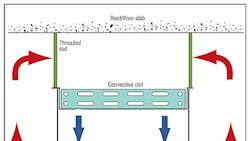Chilled beam service requires whole-building knowledge
Maintaining and servicing chilled-beam systems can be deceptive. The chilled beam itself is a relatively simple device, but as it is directly integrated into a building’s design, anyone servicing or maintaining it needs to understand the whole building concept. In addition to the device itself, service and maintenance needs to address the chilled water system, the chilled water plant, and the control system.
There are two basic types of chilled beams: passive and active.
A passive chilled beam is essentially a water coil mounted in a frame in the ceiling. As cold water passes through the coil, the air in contact with the coil becomes colder and denser and drops into the room. This air movement induces warm air from the room upwards, where it then comes into contact with the coil, and the cycle continues.
An active chilled beam works the same way as a passive beam, but receives conditioned outside air directly connected to the beam enclosure to provide a higher induction rate, increase the device’s capacity, and provide ventilation air.
The first step in servicing or maintaining a chilled beam is to keep the device clean. There are typically no filters on chilled beams, so it is advisable to regularly inspect and clean the space they are serving to ensure it’s free from dust and dirt. This is as simple as it sounds: simply wipe them down or vacuum if you find any dust or dirt accumulation.
Keeping the beams clean is particularly important in health care applications. Hospitals have an issue with air quality not usually found in commercial office buildings: lint. Due to the tremendous amount of bedding used in the patient care areas of acute care hospitals, airborne lint can—and will—accumulate in the HVAC system’s ductwork over time.
Although it would be rare for the beam itself to attract large amounts of lint (basically because the air velocity moving over the beam is so low that it lacks the energy needed to pick up and transport lint), it is still a good idea to keep a close eye on beams in these settings. Some chilled beam manufacturers offer a lint screen as an option, which is worth considering in the health care environment since it is easier to clean the screen than the beam itself.
Though lint can be an issue, the biggest concern is humidity control. This is where knowledge and understanding of the whole system come into play. Chilled beams are “dry” or “sensible” coils. Under normal conditions, no condensation will form on them. It is an important maintenance or service consideration to make sure that is the case, and remains so.
Chilled beams use water chilled to a temperature range of 55F to 57F, which is just above the typical dew point of a space (assuming design space conditions of 75F and 50 percent relative humidity). It’s very important that the chilled water system is kept operating above that dew point. If the system operates below the dew point, condensation will form on the beam, and pose a serious problem. Thus maintaining a system that stays above the dew point in the space is really what the maintenance is all about, and requires a technician who is trained in, and familiar with, controls for chilled water systems.
Monitoring the humidity within the space is vital. It requires looking at either relative humidity or absolute dew point and ensuring the controls always maintain a dew point below the point at which condensation can form on the beam.
In a commercial office building, this is very dependent on the weather. If a chilled beam system in a humid climate shuts off at the end of the day and doesn’t start up again until the morning, the humidity in the space can rise 10 to 15%. When the system starts up in the morning, the humidity in the space can cause condensation on the beams. Therefore, the first step is to monitor humidity and make sure the conditions in the space won’t cause condensation before the system starts.
If the humidity is higher than allowable or acceptable, the system must be dried out by running the dedicated outside air system (DOAS) that provides dry air to keep the space humidity below dew point. On humid days, the DOAS system must first start and run before any chilled water is sent through the chilled beams. Once the space is dried out below dew point, the chilled water system that serves the chilled beams can be started.
If running the DOAS system doesn’t reduce the space humidity to the point at which the chilled beam system can be turned on, the entire system must be shut down to identify the source of the condensation. This requires increasing the dehumidification capabilities of the DOAS system, or going back to the chiller plant and raising the temperature of the chilled water.
It’s important for technicians to understand control system alarms, and to recognize when the controls system sends a message to alert that the humidity in the space is too high for the chilled beam system to begin operating.
There are different strategies to deal with humidity in the space, and rather than involving the chilled beam device itself — which is basically a “dumb” device — they all focus on the system that is serving the chilled beam. It is knowledge of controls, understanding the controls system’s alarms, knowing what humidity levels will cause condensation, what chilled water temperatures are needed to avoid condensation, and when and how to use the DOAS to prevent condensation that will preserve a chilled beam system. Ultimately, that is how to maintain a chilled beam system.
Peter Pobjoy is chief design officer, Southland Industries, Garden Grove, CA. He can be reached at 714-901-5800 or by email at [email protected].
